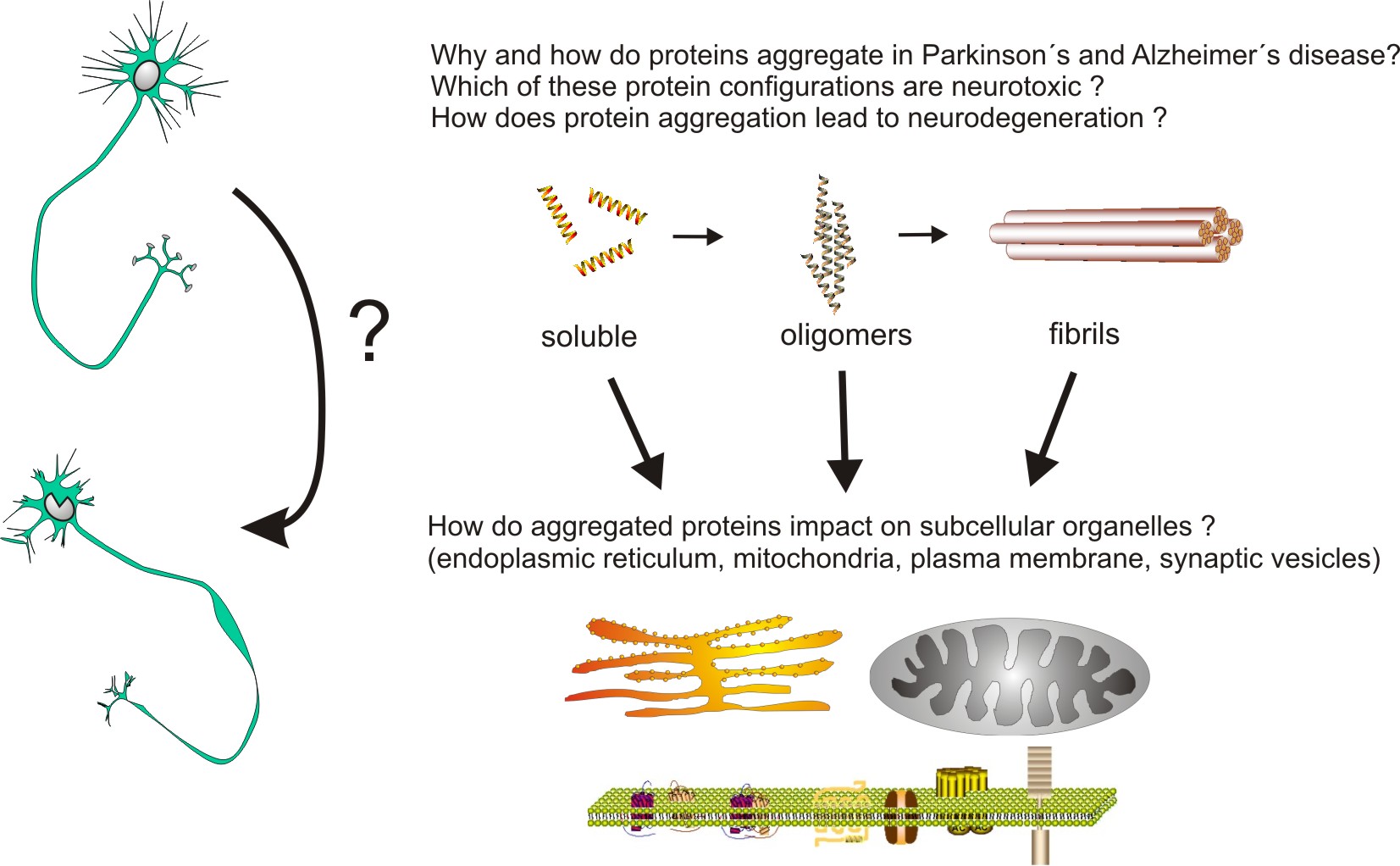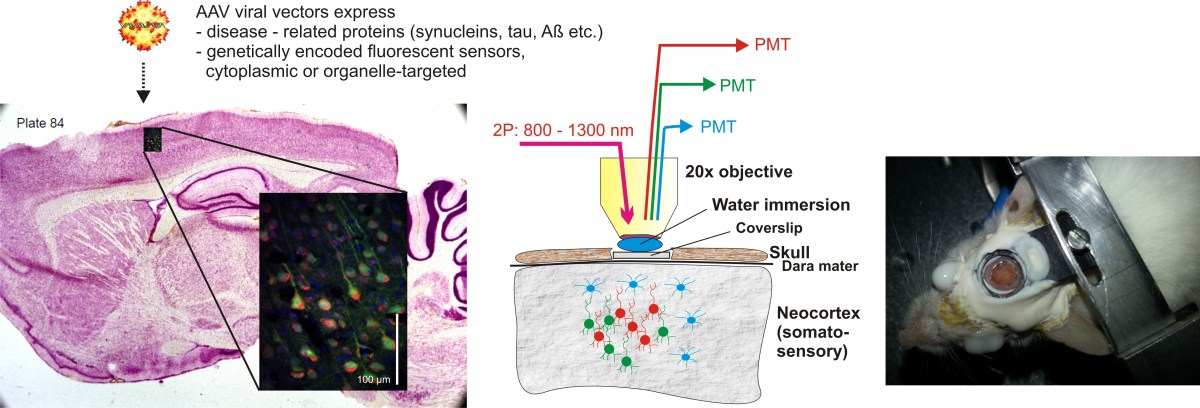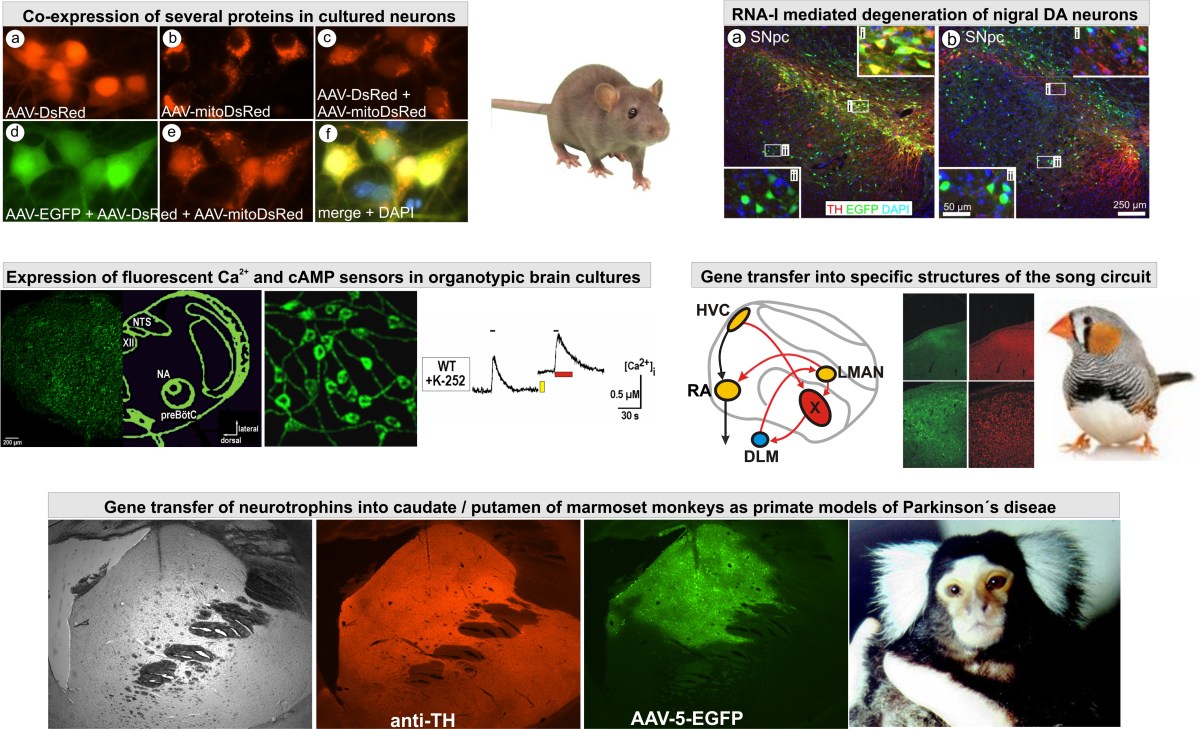AG Kügler: Mechanisms of protein aggregation in neurodegenerative diseases / Gene therapy for Parkinson´s disease
Team Leader
Dr. Sebastian Kügler

- phone:
- + 49 - 551 - 39 8351 (office)
- fax:
- + 49 - 551 - 39 14476
- e-mail:
- sebastian.kuegler(at)med.uni-goettingen.de
- phone:
- + 49 - 551 - 39 14475 (PostDocs / students office)
- phone:
- + 49 - 551 - 39 14473 (lab)
- mail:
-
Sebastian Kügler, Ph.D.
University Medicine Göttingen, Dept. of Neurology
Viral Vectors Lab, Waldweg 33
37073 Göttingen, Germany - Web:
-
- KueglerLab
Main research interests:
According to the “Consensus document on European brain research” (Olesen et al, J Neurol Neurosurg Psychiatry 77, 2006) the socio-economic burden of diseases affecting the human brain is estimated to constitute 35% of all EU disease burden. Demographic changes in ageing societies of the EU will increase this rate considerably and this will represent a crucial challenge to forthcoming generations. Therefore there is a very serious demand for evaluating mechanisms and principles of CNS disorders and also to develop novel therapeutic strategies.
 |
|
To elucidate brain pathophysiology we use viral vector mediated transgenesis of selected brain cell populations to understand, for example, the impact of miss-folded proteins like aSynuclein, Tau and Aß, or we make use of vector-driven RNA-interference to influence neuronal defence mechanisms. Currently, a major focus is on intravital imaging by 2-photon microscopy, which allows to visualize brain cells, their degeneration and the neuroprotective potential of novel therapeutics in the living brain longitudinally. Adeno-associated viral vectors (AAVs) of different serotypes and with different promoters are used to express disease-related proteins and fluorescent labels (for structural labelling) or fluorescent sensor proteins (for functional labelling) in the rodent brain. We can label a variety of brain cell types and sub-cellular organelles, and rapid recording of 3D-ZStacks is achieved within only several minutes. Such experiments allow to study the living brain with reduced efforts in animal experimentation. |
 |
|
In terms of gene therapy we are developing regulated AAV vectors towards clinical applicability. These advanced tools allow turning on and off the expression of curative transgenes (e.g. of neurotrophic factors) as an essential safety feature. Recent evidences suggest that neurotrophic factor gene therapy can be effective only if applied early after diagnosis of PD, at times when patients would still respond properly to L-DOPA substitution therapy. We feel that regulatable vectors are necessary to convince authorities that gene therapy for patients in very early disease stages is acceptable. After almost 2 decades of experience with CNS gene transfer and neurodegeneration models, we have assembled a comprehensive portfolio of viral vector based tools, neuroprotective strategies, gene therapy applications in pre-clinical models and fluorescent sensors for readout of physiological parameters. The picture below demonstrates some further examples of how we used adeno-associated virus mediated gene transfer into cultured primary neurons, the substantia nigra of the rat brain, organotypic rat brain slices, songbird and primate brain. |

|
Selected Recent Publications
- Adeno-associated
Virus-mediated, Mifepristone-regulated Transgene Expression in the
Brain.
Maddalena A, Tereshchenko J, Bähr M, Kügler S.
Mol Ther Nucleic Acids. 2013 Jul 16;2:e106 - β-synuclein
aggregates and induces neurodegeneration in dopaminergic neurons.
Taschenberger G, Toloe J, Tereshchenko J, Akerboom J, Wales P, Benz R, Becker S, Outeiro TF, Looger LL, Bähr M, Zweckstetter M, Kügler S.
Ann Neurol. 2013 Jul;74(1):109-18. -
Genetically encoded calcium indicators for multi-color neural activity
imaging and combination with optogenetics.
Akerboom J, Carreras Calderón N, Tian L, Wabnig S, Prigge M, Tolö J, Gordus A, Orger MB, Severi KE, Macklin JJ, Patel R, Pulver SR, Wardill TJ, Fischer E, Schüler C, Chen TW, Sarkisyan KS, Marvin JS, Bargmann CI, Kim DS, Kügler S, Lagnado L, Hegemann P, Gottschalk A, Schreiter ER, Looger LL.
Front Mol Neurosci. 2013;6:2. -
Reorganization of cortical population activity imaged throughout
long-term sensory deprivation.
Margolis DJ, Lütcke H, Schulz K, Haiss F, Weber B, Kügler S, Hasan MT, Helmchen F.
Nat Neurosci. 2012 Nov;15(11):1539-46. -
Calpastatin-mediated inhibition of calpains in the mouse brain prevents
mutant ataxin 3 proteolysis, nuclear localization and aggregation,
relieving Machado-Joseph disease.
Simões AT, Gonçalves N, Koeppen A, Déglon N, Kügler S, Duarte CB, Pereira de Almeida L.
Brain. 2012 Aug;135(Pt 8):2428-39 -
HDAC1 regulates fear extinction in mice.
Bahari-Javan S, Maddalena A, Kerimoglu C, Wittnam J, Held T, Bähr M, Burkhardt S, Delalle I, Kügler S, Fischer A, Sananbenesi F.
J Neurosci. 2012 Apr 11;32(15):5062-73. -
Aggregation of αSynuclein promotes progressive in vivo neurotoxicity in
adult rat dopaminergic neurons.
Taschenberger G, Garrido M, Tereshchenko Y, Bähr M, Zweckstetter M, Kügler S.
Acta Neuropathol. 2012 May;123(5):671-83 -
GSK-3 α/β kinases and amyloid production in vivo.
Jaworski T, Dewachter I, Lechat B, Gees M, Kremer A, Demedts D, Borghgraef P, Devijver H, Kügler S, Patel S, Woodgett JR, Van Leuven F.
Nature. 2011 Dec 7;480(7376):E4-5 -
Efficient gene therapy for Parkinson's disease using astrocytes as
hosts for localized neurotrophic factor delivery.
Drinkut A, Tereshchenko Y, Schulz JB, Bähr M, Kügler S.
Mol Ther. 2012 Mar;20(3):534-43 -
Chronic imaging of cortical sensory map dynamics using a genetically
encoded calcium indicator.
Minderer M, Liu W, Sumanovski LT, Kügler S, Helmchen F, Margolis DJ.
J Physiol. 2012 Jan 1;590(Pt 1):99-107. -
Dendritic degeneration, neurovascular defects, and inflammation precede
neuronal loss in a mouse model for tau-mediated neurodegeneration.
Jaworski T, Lechat B, Demedts D, Gielis L, Devijver H, Borghgraef P, Duimel H, Verheyen F, Kügler S, Van Leuven F.
Am J Pathol. 2011 Oct;179(4):2001-15 -
Moderate long-term modulation of neuropeptide Y in hypothalamic arcuate
nucleus induces energy balance alterations in adult rats.
Sousa-Ferreira L, Garrido M, Nascimento-Ferreira I, Nobrega C, Santos-Carvalho A, Alvaro AR, Rosmaninho-Salgado J, Kaster M, Kügler S, de Almeida LP, Cavadas C.
PLoS One. 2011;6(7):e22333 -
Sumoylation inhibits alpha-synuclein aggregation and toxicity.
Krumova P, Meulmeester E, Garrido M, Tirard M, Hsiao HH, Bossis G, Urlaub H, Zweckstetter M, Kügler S, Melchior F, Bähr M, Weishaupt JH.
J Cell Biol. 2011 Jul 11;194(1):49-60. -
A synthetic prestin reveals protein domains and molecular operation of
outer hair cell piezoelectricity.
Schaechinger TJ, Gorbunov D, Halaszovich CR, Moser T, Kügler S, Fakler B, Oliver D.
EMBO J. 2011 Jun 24;30(14):2793-804 -
Proliferative hypothalamic neurospheres express NPY, AGRP, POMC, CART
and Orexin-A and differentiate to functional neurons.
Sousa-Ferreira L, Álvaro AR, Aveleira C, Santana M, Brandão I, Kügler S, de Almeida LP, Cavadas C.
PLoS One. 2011 May 11;6(5):e19745 -
Probing the functional equivalence of otoferlin and synaptotagmin 1 in
exocytosis.
Reisinger E, Bresee C, Neef J, Nair R, Reuter K, Bulankina A, Nouvian R, Koch M, Bückers J, Kastrup L, Roux I, Petit C, Hell SW, Brose N, Rhee JS, Kügler S, Brigande JV, Moser T.
J Neurosci. 2011 Mar 30;31(13):4886-95. -
Epac-mediated cAMP-signalling in the mouse model of Rett Syndrome.
Mironov SL, Skorova EY, Kügler S.
Neuropharmacology. 2011 May;60(6):869-77 -
Glutathione depletion and overproduction both initiate degeneration of
nigral dopaminergic neurons.
Garrido M, Tereshchenko Y, Zhevtsova Z, Taschenberger G, Bähr M, Kügler S.
Acta Neuropathol. 2011 Apr;121(4):475-85 -
Long-distance axon regeneration in the mature optic nerve:
contributions of oncomodulin, cAMP, and pten gene deletion.
Kurimoto T, Yin Y, Omura K, Gilbert HY, Kim D, Cen LP, Moko L, Kügler S, Benowitz LI.
J Neurosci. 2010 Nov 17;30(46):15654-63 -
Modeling of tau-mediated synaptic and neuronal degeneration in
Alzheimer's disease.
Jaworski T, Kügler S, Van Leuven F.
Int J Alzheimers Dis. 2010 Aug 24;2010 -
The extracellular matrix glycoprotein tenascin-C is beneficial for
spinal cord regeneration.
Chen J, Joon Lee H, Jakovcevski I, Shah R, Bhagat N, Loers G, Liu HY, Meiners S, Taschenberger G, Kügler S, Irintchev A, Schachner M.
Mol Ther. 2010 Oct;18(10):1769-77 -
CNS-expressed cathepsin D prevents lymphopenia in a murine model of
congenital neuronal ceroid lipofuscinosis.
Shevtsova Z, Garrido M, Weishaupt J, Saftig P, Bähr M, Lühder F, Kügler S.
Am J Pathol. 2010 Jul;177(1):271-9. Epub 2010 -
Af9/Mllt3 interferes with Tbr1 expression through epigenetic
modification of histone H3K79 during development of the cerebral cortex.
Büttner N, Johnsen SA, Kügler S, Vogel T.
Proc Natl Acad Sci U S A. 2010 Apr 13;107(15):7042-7 -
Alzheimer's disease: old problem, new views from transgenic and viral
models.
Jaworski T, Dewachter I, Seymour CM, Borghgraef P, Devijver H, Kügler S, Van Leuven F.
Biochim Biophys Acta. 2010 Oct;1802(10):808-18
Search complete listing on PubMed
The Team
Shi Cheng

- phone:
- + 49 - 551 - 39 14473/-75
- fax:
- + 49 - 551 - 39 14476
Sonja Heyroth, Technical Assistant

- Lab:
- + 49 - 551 - 39 14473/-75
- Fax:
- + 49 - 551 - 39 14476
- e-mail:
- sonja.heyroth(at)med.uni-goettingen.de
Dr. Sameehan Mahajani, Post Doctoral fellow

- phone:
- + 49 - 551 - 39 4199
- fax:
- + 49 - 551 - 39 14476
- e-mail:
- sameehan.mahajani(at)med.uni-goettingen.de
Maryna Psol, Master Student

- phone:
- + 49 - 551 - 39 14473/-75
- e-mail:
- maryna.psol(at)med.uni-goettingen.de
Dr. rer. nat. Grit Taschenberger Research Scientist

- phone:
- + 49 - 551 - 39 14473/-75
- e-mail:
- gtasche(at)gwdg.de
Dr. rer. nat. Julia Tereshchenko, Research Scientist, Research Scientist

- Lab:
- + 49 - 551 - 39 14473/-75
- Fax:
- + 49 - 551 - 39 14476
- e-mail:
- tereshchenko(at)med.uni-goettingen.de
Dr. rer. nat. Muzna Zahur, Humboldt Foundation Fellow

- phone:
- + 49 - 551 - 39 14473/ -75
- e-mail:
- mzahur(at)yahoo.com
Monika Zebski, Technical Assistant

- Tel:
- + 49 - 551 - 39 14473/-75
- Fax:
- + 49 - 551 - 39 14476
- e-mail:
- monika.zebski(at)med.uni-goettingen.de